November 20, 2025 | 21:22 GMT +7
November 20, 2025 | 21:22 GMT +7
Hotline: 0913.378.918
November 20, 2025 | 21:22 GMT +7
Hotline: 0913.378.918
On May 15, in Bac Lieu city, the Department of Fisheries coordinated with the Bac Lieu Department of Agriculture and Rural Development and representatives of the UNDP/GEF SGP Program to organize a workshop "Assessing current potential status and discussing solutions to develop Artemia to adapt to climate change in the Mekong Delta."
Mr. Luu Hoang Ly, Director of the Bac Lieu Department of Agriculture and Rural Development, said that the province's aquaculture area is approximately 137,000 hectares, with 220 aquatic seed production facilities, mainly producing black tiger shrimp, whiteleg shrimp, and mud crab seeds, concentrated in Nha Mat ward (Bac Lieu city) and Ganh Hao town (Dong Hai district). Every year, these facilities produce about 30–35 billion Postlarve, basically providing enough shrimp seed for farmers in the province and selling it to provinces in the Mekong Delta region.
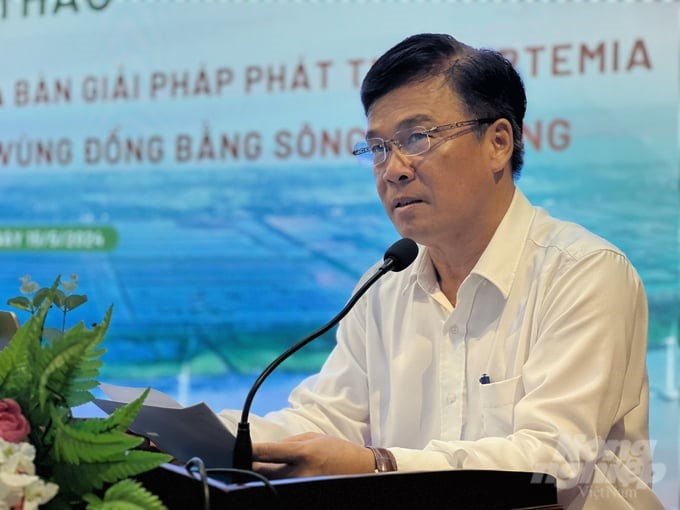
Mr. Luu Hoang Ly, Director of the Bac Lieu Department of Agriculture and Rural Development, spoke at the workshop. Photo: Trong Linh.
Therefore, the demand for Artemia eggs in aquatic seed production is now very large. However, currently in the province, there is only one Artemia egg production factory and three cooperatives specializing in Artemia farming, meeting only about 5–10% of the actual needs of local seed production and nursery facilities. The remains are mainly imported from countries such as the US, China, and Russia.
According to assessments, the coastal land of Bac Lieu province has soil, climate, and salinity characteristics suitable for Artemia farming. Artemia eggs have superior qualities compared to those in other parts of the world, such as their small size, high hatching rates, high nutritional content, and easy preservation without using any preservatives or other hatching agents.
With the outstanding quality of Artemia eggs raised in the coastal land of Bac Lieu province, Artemia eggs originating from Vinh Chau (Bac Lieu) are assessed by customers to have the best quality in the world.
Through the process of building and promoting the brand, this product has been widely consumed in the domestic market and exported to many countries around the world, especially demanding markets that prefer high-quality products, such as Japan, Thailand, and many European countries.
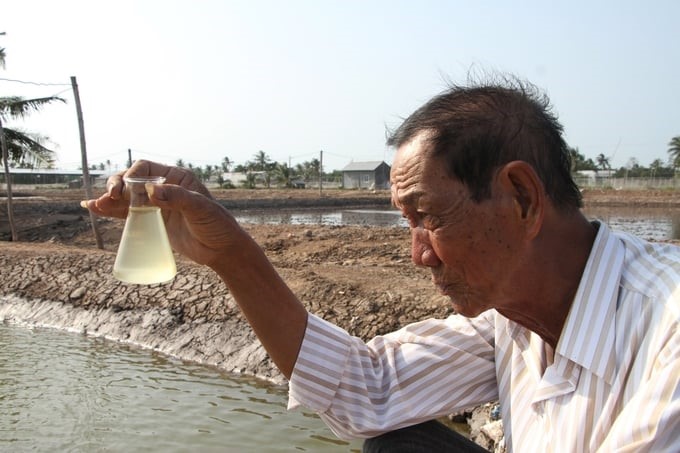
Vietnam's Artemia quality is highly appreciated by customers. Photo: Trong Linh.
Bac Lieu is a province with strength in brackish water shrimp seed production. Every year, the province produces over 30 billion Postlarve because natural food is the best source of nutrition, fully meeting the nutritional needs for the development stages of shrimp.
Accordingly, Artemia has been commonly used in brackish water shrimp seed production to improve the quality of shrimp seeds, providing quality seeds for farmers thanks to their rich nutrition and convenience in use and preservation. Based on the urgent requirements of production practices, every year, 220 brackish water shrimp seed production facilities in Bac Lieu province need to use about 150 tons of dried Artemia eggs for larvae nursery. Hatcheries use dried Artemia eggs according to standard procedures.
According to Mr. Tran Dinh Luan, the current demand for domestic Artemia is about 19 tons (accounting for 4%) and the demand for imported Artemia is 433 tons (accounting for 96%).
Currently, Artemia eggs are mainly imported from the US, Russia, and China. Vietnam also produces Artemia in Vinh Chau on a small scale, not meeting domestic demand. Besides, the price of locally produced Artemia is high, so it is rarely used despite its very good quality.
Mr. Tran Dinh Luan, Director of the Department of Fisheries (Ministry of Agriculture and Rural Development), affirmed: Vietnam's current demand for Artemia is very large and needs to be exploited, especially for use as food for ornamental fish. In 2023, domestic Artemia production only reached 9 tons, concentrated in the two provinces of Bac Lieu (6 tons) and Soc Trang (3 tons), while imported Artemia output was nearly 667 tons, accounting for more than 99%.
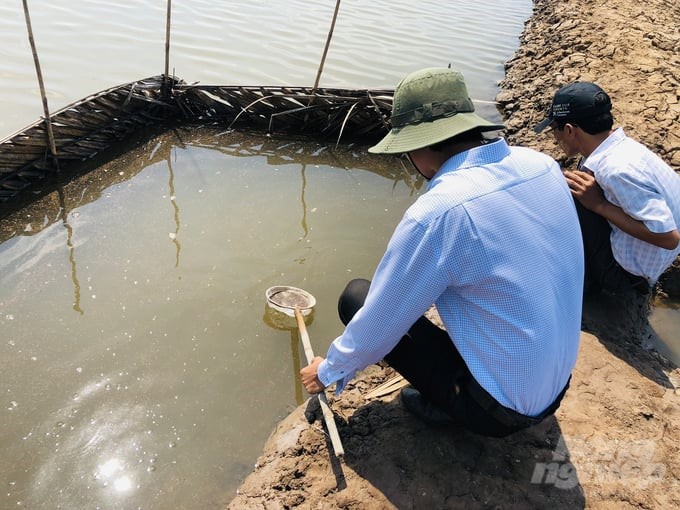
The current demand for Artemia is very large. Photo: Trong Linh.
According to Mr. Tran Van Thua, Director of Doanh Dien Salt Farming Cooperative (Dong Hai district, Bac Lieu), the Cooperative previously specialized in salt production. However, because salt prices were too unstable, the lives of cooperative members faced many difficulties. So in 2015, the Cooperative linked to convert to Artemia farming.
With the linkage with Vinh Chau – Bac Lieu Artemia Cooperative, Danh Dien Salt Farming Cooperative converted a part of the area to Artemia farming, and Artemia grew well. Artemia farming has low capital investment and an early harvest, so it is very suitable for the Cooperative's households lacking production capital as well as many households in the area.
The Artemia production cooperation process of Doanh Dien Salt Farming Cooperative is very convenient thanks to Vinh Chau – Bac Lieu Cooperative's support in production conversion planning and annual investment in initial production costs such as seeds, operating costs, food, materials, fertilizers, etc., especially direct technical support. Besides, the Cooperative has also received support from the State to build its headquarters.
"After the linkage, Artemia is purchased at a very high and stable price; all products are consumed at market prices. If farming output reaches 80 kg/ha, the profit is higher than salt production. In addition, Artemia can be raised in combination with salt and bittern production. Shrimp and crab farming on the Artemia farming land in the rainy season is also very effective," said Mr. Tran Van Thua.
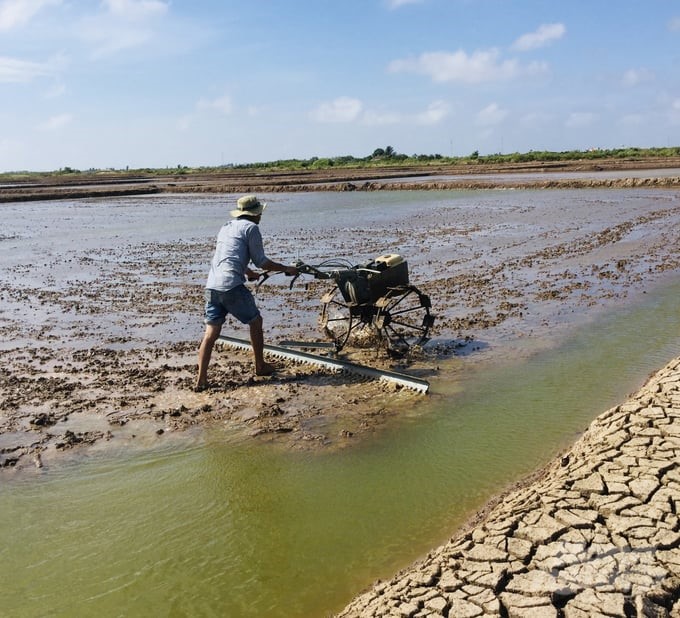
People improve Artemia farming ponds. Photo: Trong Linh.
However, according to the Director of Danh Dien Salt Farming Cooperative, the difficulties facing Artemia farmers today are environmental pollution and climate change, especially in years when the rainy season ends late. Therefore, it is necessary to pay attention to environmental protection and have colored ponds to treat pollution. The early onset of the hot sun also shortens the crop season, affecting productivity and output. "This year, although Artemia production was quite favorable, we only obtained 750 kg/10 ha; productivity reached 75 kg/ha due to intense and prolonged hot sun," Mr. Thua said.
Therefore, Mr. Thua recommends support for investing in salt water storage ponds for early stocking and applying new technical measures to achieve high productivity. If properly invested, Danh Dien Salt Farming Cooperative can increase the Artemia farming area to over 20 hectares and productivity to over 100 kg/ha, and profits will be very good.
Mr. Cao Thanh Van, Chairman of the Board of Directors of Vinh Chau – Bac Lieu Artemia Cooperative, shared: The Cooperative was established and went into operation in early 2003, operating in the investment field of Artemia egg production for domestic consumption and export.
The Cooperative has organized a production linkage chain in the form of technical support, investment in seeds and food, and purchasing all products at market prices for four cooperatives, including three cooperatives in Bac Lieu province and one cooperative in Soc Trang province. Besides, the Cooperative has also invested directly in many farming households. For a long time, Vinh Chau – Bac Lieu Artemia Cooperative has linked production on a farming area of about 300 hectares with over 200 participating farmers, achieving an average output of around 20 tons of fresh eggs/year.
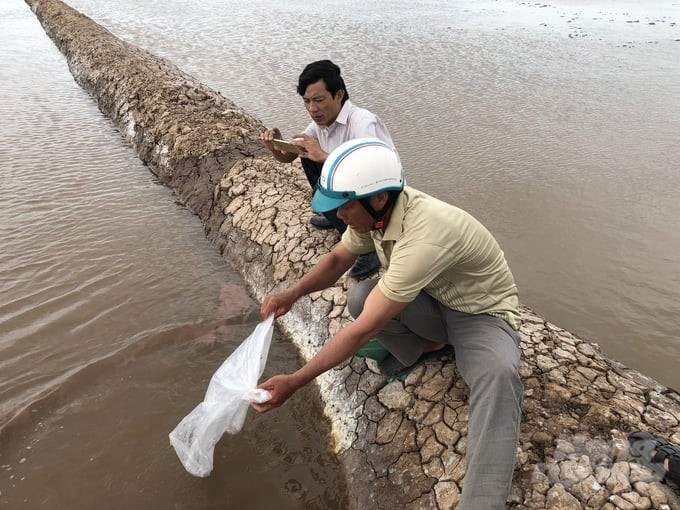
Bac Lieu Agricultural Extension Officer (white shirt) provides technical support in Artemia farming to farmers. Photo: Trong Linh.
According to Mr. Van, in 2024, the Cooperative will deploy Artemia farming on an area of 150 hectares, including 50 hectares in Bac Lieu and 100 hectares in Soc Trang. If the productivity reaches 100 kg/ha, with a purchasing price of VND 1.1–1.2 million/kg, the profit is estimated at VND 80 million/ha.
Mr. Tran Dinh Luan, Director of the Department of Fisheries (Ministry of Agriculture and Rural Development), affirmed that Vietnam's Artemia has good quality, while demand is very large. Currently, many production facilities and individuals have raised Artemia with experience.
“We have also formed concentrated farming areas to produce Artemia in accordance with the soil characteristics in Bac Lieu and Soc Trang, especially forming a linakge chain of production and consumption at high prices for cooperatives and farmer households," Mr. Luan shared.
Translated by Thu Huyen

(VAN) This is the study conducted by IRRI and Can Tho University on the rice straw value chain in Mekong Delta showing an economic potential of more than 6.6 trillion VND/year.

(VAN) By participating in cooperative economics, many farmers in Tay Ninh have overcome hardship, mastered clean dragon fruit cultivation techniques.

(VAN) The crossbreeding program in the former Binh Dinh province (now part of Gia Lai) has shown signs of decline, and urgent measures are needed to revive it and sustain past achievements.

(VAN) The agricultural sector agreed on a roadmap to pilot the MRV protocol and expand low-emission rice production from the 2025-2026 winter-spring crop.

(VAN) Agricultural extension officers in Quang Ninh do more than transmit knowledge; they have become a steadfast support system for farmers on the path to sustainable agricultural development.

(VAN) The development of a high-quality beef cattle herd has brought major benefits to livestock farmers, creating jobs and enabling better use of agricultural by-products.

(VAN) In the eastern region of Gia Lai, crossbred cattle now account for 93%, forming a high-quality beef herd and establishing a recognized brand, the result of 35 years of persistent effort.